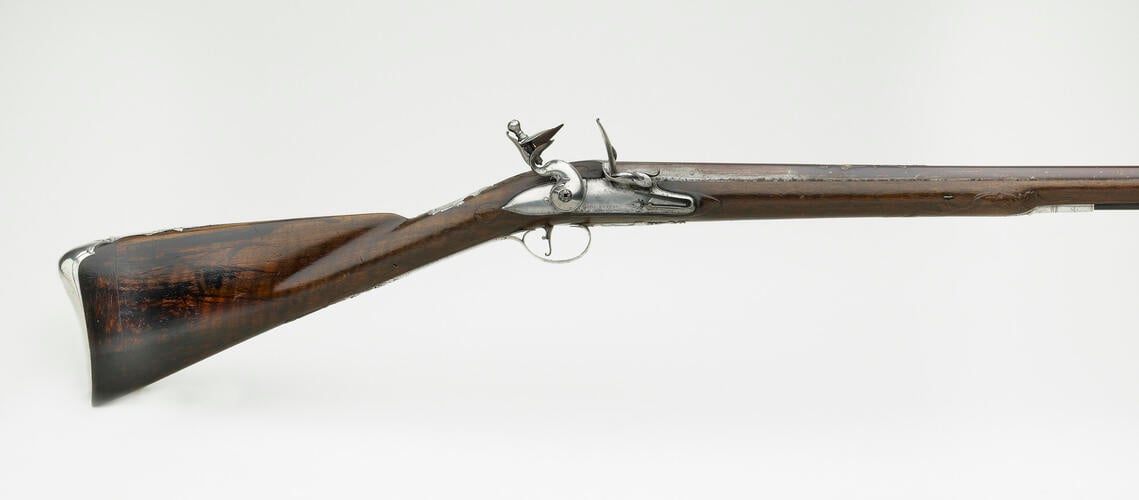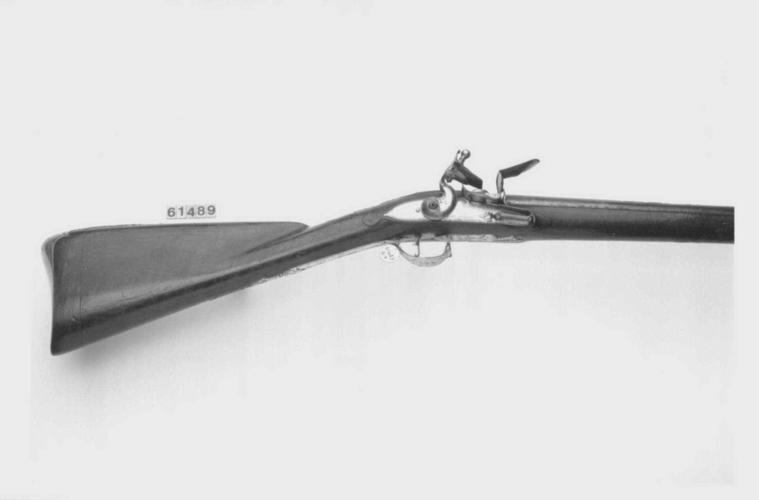-
1 of 253523 objects
Flintlock gun, one of a pair 1729
Walnut, browned and gilt steel, silver | 130.0 cm (whole object) | RCIN 61489
-
Flintlock fowling piece with a browned steel tapering barrel, carved walnut stock with repoussé and engraved silver mounts, including a trophy of hunting scene and a classical warrior's head above arrows on the heel; escutcheon plate with the coat of arms of Frederick, Prince of Wales. Ebony ramrod with silver tip.
In the Daily Journal of 7 November 1729, Harman claimed that he had made shotguns with barrels only 30 in (76.2 cm) in length which ‘out-shot other Guns from 6 to 12 inches longer’. Much of the debate in shooting circles of the time was about the ideal length of barrel, weighing accuracy against balance. George Edie’s guide to shooting noted that: ‘As to the apparent good properties of one of our modern Pieces, they may be reckoned thus: the barrel of a tolerable large bore, and very smooth, with a handsome outside, and the length from three foot to three foot six inches; the lock rather small, with good and strong springs; the stock neat, not too much bent in the butt; and on the whole, the Piece to rise light and handy to the shoulder; the mounting may be according to fancy’. For this pair of flintlock guns (RCIN 61489 and 61490) Harman chose longer barrel lengths, and in the instance of one of RCIN 61490 the stock has also been lengthened.
John Harman was apprenticed to John Shaw (active 1673-1720), who had been Gunsmith-in-Ordinary to every monarch from Charles II to George I. In 1729 Harman became Gunmaker to Frederick, Prince of Wales. As well as the Prince’s coat of arms on the escutcheons, the barrel tangs have been engraved with a thistle and two roses, and with a pair of daffodils in reference to their princely patron. A bill in the Duchy of Cornwall accounts from Harman, dated 20 March 1729, charges for ‘a fine shot gun mounted in silver at 60 guineas as pr agreement’; it was sold with a tortoiseshell and silver powder-flask at a further 4 guineas.
Text adapted from The First Georgians; Art and Monarchy 1714 - 1760, London, 2014.Provenance
Probably commissioned by Frederick, Prince of Wales in 1729. The gun was in the collection of George III, and was taken from Augusta Lodge to Carlton House in 1822.
-
Creator(s)
(gunsmith)Acquirer(s)
-
Medium and techniques
Walnut, browned and gilt steel, silver
Measurements
130.0 cm (whole object)
91.4 cm (barrel length)
1.82 cm (Width) (caliber (diameter of gun))
Category
Other number(s)
Bibliographic reference(s)
Blackmore, H.L. 1968 Royal Sporting Guns at Windsor. London HMSO


